This is the website of Abulsme Noibatno Itramne (also known as Sam Minter).
Posts here are rare these days. For current stuff, follow me on Mastodon
|
I am planning today to go to the Republican Caucuses here in Washington state. Doors open in about 30 minutes, you have to be signed in about 60 minutes from now, and 90 minutes from now the “action” should get started.
Assuming I am able to, I will be live tweeting as things progress. The tweets will appear on abulsme.com at a few minutes before 00:00 UTC in daily summary form, or you can follow me on Twitter to get updates in real time:
@abulsme
If I understand correctly, there will be a straw poll vote (which will be what is reported first by the press, but doest really matter), then there will be speeches and such, and then delegates will be picked for the county conventions. Those delegates will state their preferences most likely, but will not be bound in any way at the next level. Washington has 40 delegates, 30 will be winner take all 3 at a time by congressional district, and 10 will be proportional based on the state wide vote.
For the record, I plan on expressing my preferences (I hesitate to call what happens at a caucus actual voting) for Ron Paul. Of the four remaining Republican candidates, he is my preference by far. In terms of caucus participation, I am a Republican for the day, but at this point I am not ready to commit to what I will do in November. We shall see. And there will likely be other choices besides the Republican and Democrat, some of which may be interesting.
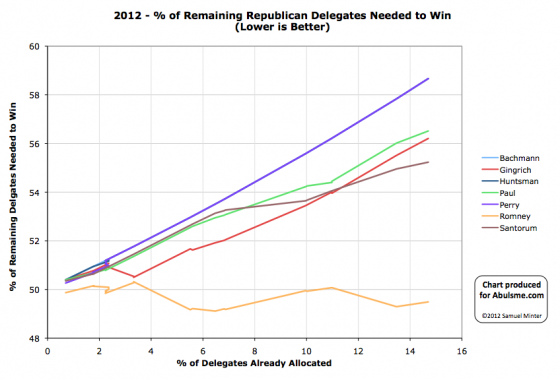
Chart from the Abulsme.com 2012 Republican Delegate Count Graphs page. When a candidate gets down to 0%, they have cinched the nomination. If they get up past 100%, they have been mathematically eliminated. Rather than the date on the x-axis, we show the “% of Delegates Already Allocated” as this better represents the progress through the race. Note that these numbers include estimates of the eventual results of multi-stage caucus processes which will be refined as the later stages occur.
So, first of all, that final congressional district in Michigan went for Santorum, so 2 more delegates for Santorum, making the final Michigan numbers 15 for Romney and 15 for Santorum, which was an exact match for my Scenario 2 in the post gaming out Arizona and Michigan.
Secondly, we have Wyoming. It is very important with Wyoming (as with similar caucuses previously) to point out that no national delegates were actually allocated in Wyoming yet. There was a straw poll, which doesn’t matter, and local delegates were selected for the next stage in the caucus process that will eventually select delegates to the national conventions. Ideally, each local delegate who was selected would be polled for their presidential preferences, and that would be used to predict results at the next level, etc. But that would be a ton of work, and nobody is doing that. Our source for these things, The Green Papers is doing the estimating by using the straw poll numbers for all candidates who got more than 5%. These estimates WILL change (perhaps significantly!) when the later caucus stages happen, but for now that is what we have. Green Papers estimates Wyoming as: Romney 10, Santorum 8, Paul 6, Gingrich 2.
And so when we pump this into the grinder and look at the “% of remaining needed to win” charts that I argue are the best way to see what is really happening… we find out… EVERYBODY LOSES. All four candidates in the race got delegates since my last update yesterday, but none of them got the delegates at the rate they would need to in order to get to 1144. Romney of course came closest. He got 10 out of 28 delegates today, or 35.7% of the delegates. But he needed to get 49.3% of the delegates (at least 14 of today’s 28) to actually be on pace to get to 1144.
Romney is still way ahead though. Right now he needs 49.5% of the remaining delegates to win. Santorum is in second needing 55.2% of the remaining delegates to win.
We are still fundamentally in a state where if Romney continues the way he has been, he will get to 1144, but very very late in the process… but with the possibility of the non-Romney’s blocking him still real. The non-Romney’s only have to do a little better than they have been to block Romney. One of the non-Romney’s actually catching up and winning gets to be an increasingly remote possibility as we move on though. Still not impossible. Just getting very hard. You would basically need consolidation around one non-Romney at the same time that Romney himself lost a significant amount of support.
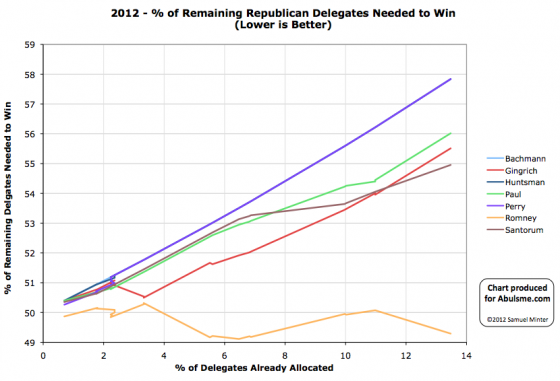
Chart from the Abulsme.com 2012 Republican Delegate Count Graphs page. When a candidate gets down to 0%, they have cinched the nomination. If they get up past 100%, they have been mathematically eliminated.
The chart above is now the chart using the “% of delegates already allocated” as the x-axis rather than the date, because I think it more clearly shows what is actually going on at this point.
Romney picks up all 29 delegates from Arizona. As of this update the best estimates at The Green Papers gives Romney 15 delegates from Michigan, Santorum 13, and 2 delegates still too close to call. Those of you who read my Gaming Out Arizona and Michigan post will recognize Scenario 2, which at the time I said was the most likely result, and indeed, that is what happened. If the last outstanding congressional district ends up going for Santorum, then it will actually match Scenario 2 exactly. Regardless though, the general outlines of Scenario 2 are met, and I’ll just quote my analysis from that earlier post:
Romney is still the only winner here. It is clearly not as big a win [as if he had won nearly all of Michigan’s delegates through a more geographically even win], but Romney still makes his “% of remaining delegates needed to win” go DOWN, and go down to under 50%. Santorum, despite getting some delegates, is still in a worse position than when he started the night. Before he needed 54.1% of the remaining delegates to catch up and win the nomination, now he needs 54.9% [actually 55.0% pending disposition of those last 2 delegates]. Santorum does pull ahead of Gingrich though, and put himself clearly into second place. But the three non-Romney’s in this situation are still all heading upward (toward being mathematically eliminated), none of them has started to actually move down toward catching up and winning. Romney in this situation does improve a bit here, but also still isn’t breaking out downward yet. He is still hovering in the zone where his opponents (collectively) only have to do a little bit better to block him from getting the nomination. Note that they do have to do better though. Paul, Gingrich and Santorum could keep getting delegates at the same rate, and Romney would still get the nomination, it would just take awhile.
Attention now moves to first Wyoming and Washington (although they are not getting much attention) and then of course Super Tuesday. Super Tuesday is not as super as it was in 2008, but there are still a big chunk of delegates at stake, and after it is over, we should have a better view of what the rest of the race looks like, and specifically if Romney is able to break out and start closing on 1144, or if the non-Romney’s still have a real shot at blocking him from getting there. (Let alone actually catching up and winning, which is a much further stretch.)
I was asked a few hours ago about the possibilities of nobody getting enough delegates to wrap up the Republican nomination and somebody who isn’t running today jumping in. I answered by email, but thought it was worth posting as well. Also, I’d be remiss to not point out that Ivan and I also discussed how the next bit of the race might play out on this week’s Curmudgeon’s Corner, so take a listen to that too. Anyway, my answer:
The most likely scenario is still that Romney gets to 1144, and does so without any special shenanigans. However…
A) The calendar is extremely spread out this year. We need to get to the end of March just to be where we were at the beginning of February in 2008. McCain pulled ahead by an uncatchable margin on Super Tuesday in 2008. We won’t have a comparable number of delegates selected for many more weeks now. So the story will be all about how Romney is having trouble closing, even though really we just aren’t as far along in the process yet.
B) So far Romney has been chugging along at a pace that will get him to 1144, but essentially at the last possible moment. We’re talking well into the Spring before he mathematically actually gets the magic number. If he continues at that pace, he will limp into the convention wounded and weak, and challenges may well be possible, causing fun drama. He desperately needs to start winning delegates by a wider margin than he has been, because…
C) While each of the non-Romney’s alone are not doing very well in the delegate race, collectively they just have to do SLIGHTLY better than they have been so far, not to win, but to block Romney from getting to 1144. For this to happen though, the collective non-Romney numbers have to improve… just a tiny bit, but they have to improve. So you have to have Santorum or Gingrich (and Paul) continue to pull delegates and just plain not collapse or run out of steam. Note, at this point some of the few Super Tuesday polls out there show this is a non-Trivial possibility. I’ve seen polls for Georgia (Newt ahead), Ohio (Santorum ahead), and Tennessee (Santorum ahead). And is it hard to believe that Alaska, Idaho, North Dakota, Oklahoma, and Wyoming won’t include a decent delegate haul for Santorum and/or Newt or Paul? (Even if we give Romney Massachussetts, Vermont and Virginia?) There has been light or non-existant polling in those places so far, but I look at them and think it is more than possible that even if Romney “wins” that night, he might do so with a plurality of the delegates rather a decisive over 50% margin. In that case, he’d still be way ahead in delegates, but the other three will have once again succeeded in not letting him get enough to be closing toward 1144 fast enough to get there. (Detailed gaming out of this from FHQ here: http://frontloading.blogspot.com/2012/02/very-rough-estimate-of-republican.html and here: http://frontloading.blogspot.com/2012/02/very-rough-estimate-of-republican_19.html )
D) Given the above, my actual position is what it has been for the last month or so… it will PROBABLY still be Romney, and he will PROBABLY win it outright, but the picture will be a lot clearer after Super Tuesday. We will then have over 35% of the delegates allocated, as opposed to only 11% like we do today. If after Super Tuesday, Romney’s “% of remaining delegates needed to win” number (the one I’ve been posting graphs about regularly) isn’t heading dramatically downward, then it will be very legitimate to start talking about the possibilities of him not getting to 1144. Right now it is fun to think about, but still unlikely. (Let alone the possibility of one of the others actually being on pace to catch up and win, which CAN STILL HAPPEN, but requires a complete Romney collapse.)
E) Unless Romney does a blow out win on Super Tuesday and crushes everybody else, assume that the press will make it out to be a race as long as anybody else is standing at all. Just like they did with Clinton vs Obama, they will pump it up and act like whoever is in 2nd has a chance to catch up long after they really don’t have any real chance of doing so at all. Watch my graphs. If after each contest Romney’s “% to win” goes down, and everybody else’s goes up, then Romney is walking toward the nomination, don’t let any of the hype delude you.
F) OK, lets say that Romney does NOT get to 1144, what then? Well, chances are, as long as he is way ahead in delegates compared to the others, he will probably still be the nominee. Deals will be made. Maybe none of the others actually drop out and throw their support before the convention, they get to get their votes in the roll call and make a big speech, but in the end, the deal is made. One or more of the other guys instruct their delegates to go for Romney on the 2nd or 3rd ballot or whatever in exchange for “something” and Romney gets it. This deal will probably be made before the convention, but worst case scenario, the deal is made by appealing directly to the delegates at the convention, and it ends up being Romney.
G) If the convention is indeed deadlocked, and decides to go with none of the four currently in the race, well, that would just be crazy fun chaos. But the big name candidates that everybody wanted to get in but didn’t will be running away from it as fast as they can. There are good reasons they decided to sit out 2008. Are they going to suddenly decide to want to come into that situation starting way late, starting way from behind, and inheriting a divided and discouraged party? Any reasons they had not to run earlier will be even stronger then. Maybe one could be “called to duty” and reluctantly accept, but would they really be doing anything other than making themselves weaker for 2016? And would a third or fourth tier possibility really be any better to all the assembled delegates? It would be a delightful mess to watch though. Still very unlikely though. There is a path to get to this, but it is very narrow, and all of the above are much more likely…
H) Oh, and of course the only thing even more fun than that kind of chaos, would be the convention not being able to select a candidate even after many ballots, breaking up into multiple conventions selecting different candidates… and splitting the party into two or more pieces. Of course, there are even MORE things that would prevent that, so that is too crazy for even me to contemplate right now. :-)
OK, we have a couple states coming up in the next week, and a lot has been made about what happens if Santorum wins, etc. Now, a lot of that analysis is based on the momentum Santorum would gain going into Super Tuesday, but lets just look at the delegates for a minute, and see what would happen under various scenarios.
First thing to remember for all this is the way the delegates are allocated. Arizona is winner takes all with 29 delegates at stake. Michigan is more complicated. 30 delegates are at stake. A grand total of TWO delegates are determined proportionately based on the state wide primary results. (So these will almost certainly just be 1 each to the top two candidates unless it is a blow out.) The other 28 delegates are allocated winner take all by congressional district. Michigan has 12 congressional districts, each district determines 2 delegates. So in Michigan, the delegate result depends quite a bit on how candidate’s support is distributed geographically, the overall statewide numbers will not tell the whole picture.
Second item before we start looking at scenarios… where we are in the polls right now:
And of course the starting point for all this is the current state (as of February 25th) on my Delegate Count page. (Sources and methodology and such explained there.)
OK, so now looking at a few possibilities, in order from best for Romney, to best for Santorum. Note that the actual results will not likely exactly match any of these scenarios, but rather these give several types of results that characterize the kinds of outcomes that might happen.
Scenario 1
First up, current polling, plus Romney’s support in Michigan is uniform across the whole state, so he wins all of the congressional districts too. Result in this scenario, Romney gets 58 delegates for the night, Santorum gets 1.
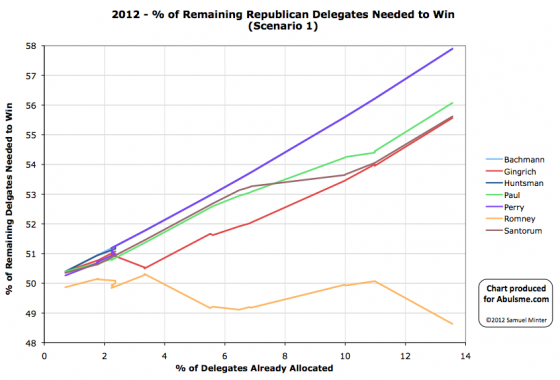
OK, obviously Romney is the big winner here. He moves down (toward the nomination) significantly. He only needs about 48.6% of the remaining delegates to win. The closest competition would still be Gingrich, although Santorum would only be one delegate behind. Gingrich and Santorum would both need about 55.6% of the remaining delegates to catch up and win. Still not an impossible number if Romney completely collapses, or even if one of them drops out and the other gets all their support (plus a bit). And with some wins in big winner take all states, it could be done. But 55.6% is starting to be a big number. And it is a LOT more than the 14.5% of the delegates these two would have gotten so far. The “catch up and win” possibility gets much further away with this result. And even the “Stop Romney from winning” possibility gets further away, as Romney continues to pile up the delegates.
Scenario 2
OK, now lets take current polling, but pretend the results in the various districts is such that the districts divide in about the same way as the popular vote goes between the two top candidates. Essentially in this scenario, Romney and Santorum split Michigan with 15 delegates each. (And Romney still wins Arizona.) So for the night, Romney gets 44 delegates and Santorum gets 15. Please note, and this is important: You get essentially the same result here regardless of who actually wins the state popular vote! As long as it is close, and the candidates essentially split the congressional districts, you get this sort of result. Depending on how many CDs are actually won by each candidate, you move the numbers a little, but the essential result is the same. With this kind of result, the state popular vote bragging rights matter ONLY to the media narrative that will build (and therefore any effects on later contests)… but they do NOT matter to the actual delegate numbers.
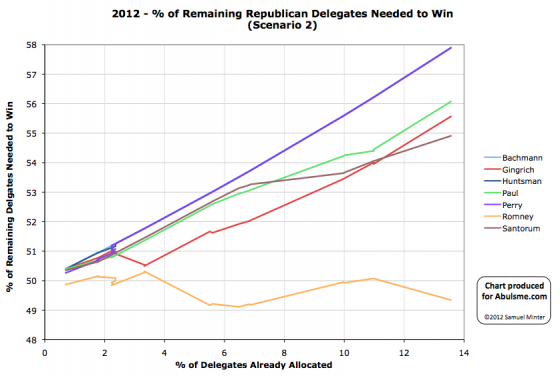
Romney is still the only winner here. It is clearly not as big a win, but Romney still makes his “% of remaining delegates needed to win” go DOWN, and go down to under 50%. Santorum, despite getting some delegates, is still in a worse position than when he started the night. Before he needed 54.1% of the remaining delegates to catch up and win the nomination, now he needs 54.9%. Santorum does pull ahead of Gingrich though, and put himself clearly into second place. But the three non-Romney’s in this situation are still all heading upward (toward being mathematically eliminated), none of them has started to actually move down toward catching up and winning. Romney in this situation does improve a bit here, but also still isn’t breaking out downward yet. He is still hovering in the zone where his opponents (collectively) only have to do a little bit better to block him from getting the nomination. Note that they do have to do better though. Paul, Gingrich and Santorum could keep getting delegates at the same rate, and Romney would still get the nomination, it would just take awhile.
Scenario 3
OK, now lets say Santorum reverses the poll momentum and ends up winning the popular vote in Michigan. As mentioned above, if his support is “lumpy” around the state, and both Romney and Santorum end up getting significant numbers of delegates, then we just have Scenario 2, plus or minus a few delegates depending on exactly how many congressional districts each candidate wins. So for this scenario, lets pretend that Santorum actually wins with his support uniformly distributed across the state and Romney wins no congressional districts. Then we have Santorum getting 29 of the state’s delegates, and Romney getting only 1. So for the night that would make it 30 delegates for Romney, 29 for Santorum. Note that despite Santorum “winning” Michigan, Romney still gets more delegates for the night because of Arizona and the 1 proportional Michigan delegate.
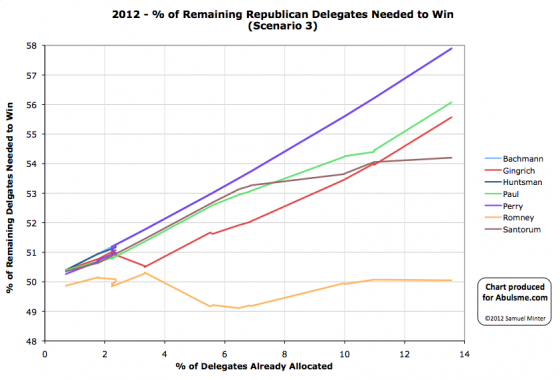
Romney is STILL the only actual winner in this situation… although just barely. He goes from needing 50.07% of the remaining delegates to win, to needing 50.05% of the remaining delegates to win. Essentially he is flat.
Santorum, despite winning Michigan in a pretty convincing way, is still worse off than coming into the day. Going in he needed 54.1% of the remaining delegates to win, now he needs 54.2% of the remaining delegates. But essentially this is flat. Once again though, Santorum does pull head of Gingrich (by an even bigger margin than Scenario 2 of course) and plants himself solidly in second place. (Although still quite a long ways back from Romney).
This scenario does however keep Romney hovering around the 50% of remaining delegates needed to win line, while having gotten just 50% of the delegates so far. This is the path to getting 1144 at the last possible moment before the convention. Obviously Romney would like to do a bit better than that as just the slightest misstep at this rate of delegate collection could cause him to end up just short of the magic number.
Scenario 4
OK, now lets imagine that Santorum comes back from behind unexpectedly in Arizona, but at the same time Romney consolidates Michigan and wins there in every congressional district. Since this involves momentum going in different directions in different states, this seems unlikely, but lets include it for completeness.
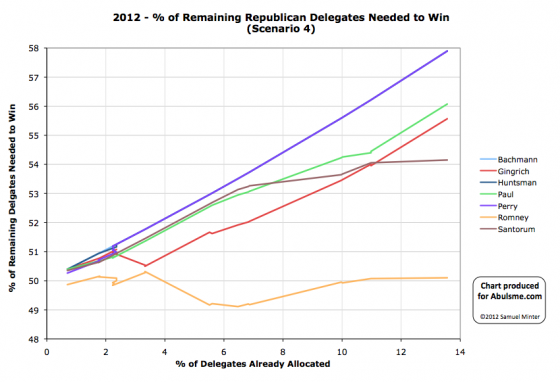
In this scenario EVERYBODY LOSES. Nobody gets enough delegates to actually be on a pace to win the nomination. Santorum does pull ahead of Gingrich, so there is that. And he does win the night. But just barely. And not by quite enough to actually be catching up fast enough to get to 1144.
Scenario 5
Romney and Santorum split Michigan (either might win the popular vote, but they split the congressional districts), but Santorum does a come from behind victory in Arizona. So for the night we get 44 delegates for Santorum and 15 for Romney.
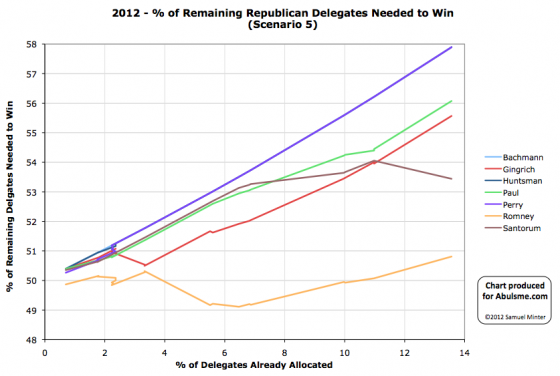
We now for the first time have a situation where Santorum actually clearly wins the night. His “% of remaining delegates needed to win” actually drops… from 54.1% down to 53.4% of the remaining delegates. Meanwhile, Romney gets knocked backwards. Rather than needing just 50.1% of the remaining delegates he now needs 50.8%.
Now, Romney is still in the lead here, and by a decent margin, but with a result like this for the first time since Gingrich won South Carolina, someone would actually be improving their position in the race versus Romney.
Scenario 6
Once again we imagine the Santorum upset in Arizona, but this time combine it with the widespread win in all Michigan congressional districts. This is Santorum’s dream scenario. Here he gets 58 delegates for the night compared to only 1 for Romney.
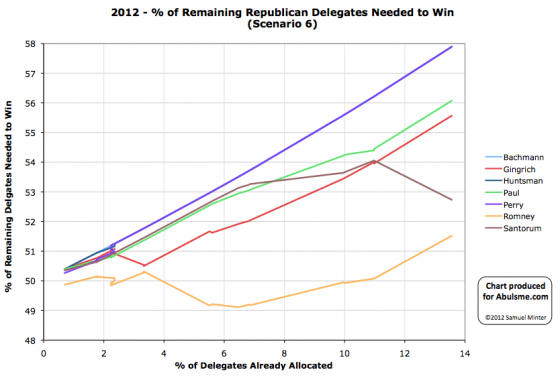
Here Santorum wins the night decisively.
After a night like this, Romney would still be ahead, but would be back below 50% of the delegates allocated so far and he would actually be moving quickly away from the nomination rather than closer to it, and Santorum would be gaining at an alarming rate. Of course, winning a winner take all state, plus almost all of the delegates from another state will do that. Romney would be in deep trouble in this scenario and while sell behind, Santorum would now be nipping at his heels.
Conclusion
All the hype is about Michigan because it is close. And because a Santorum win there will get everybody excited about “momentum”. And indeed, that kind of victory followed by the media frenzy that followed, could indeed move poll numbers in the subsequent states, most critically the Super Tuesday states…
But in terms of where the delegate race stands today, Michigan is not enough. For Santorum to actually get a substantive victory on Tuesday, not just one that he hopes will lead to bigger victories down the line, then he HAS to win Arizona too. The only situations where Santorum is actually on a pace to win the nomination himself are ones where he wins Arizona as well as a substantial number of the congressional districts in Michigan. Even with a widespread win in Michigan where Santorum wins all 14 congressional districts, if he loses Arizona, then Romney still gets more delegates for the night, and Santorum isn’t on a pace to catch up.
Of all the scenarios above, my best guess is that we will be closest to Scenario 2 than anything else. Which would mean that regardless of the state wide popular vote winner, Santorum and Romney split the Michigan delegates, and Romney wins Arizona. Which is a win for Romney in the delegate race, and by a decent margin.
Of course, if Santorum does win Michigan’s overall state popular vote, expect all the talk to be about that and the momentum he gets out of it. We won’t hear much about how actually Romney is closer to the nomination than he was before, even despite the Michigan result.
If Santorum does pull off a surprise in Arizona though… well, that is a completely different story.
Edit 2012 Feb 26 16:02 UTC for minor wording clarification.
Edit 2012 Fev 29 14L57 UTC to fix typo.
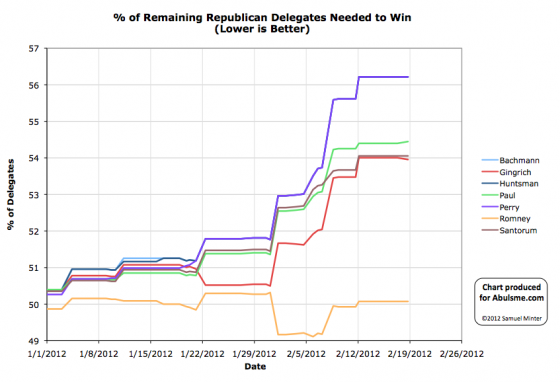
Chart from the Abulsme.com 2012 Republican Delegate Count Graphs page. When a candidate gets down to 0%, they have cinched the nomination. If they get up past 100%, they have been mathematically eliminated.
A small change today. Maine revised its preference poll numbers to add some precincts whose results got lost in a spam folder (really). The result from this is that the delegate estimates give one less delegate to Paul, and one more to Gingrich. So Gingrich wins the day today.
But Maine’s results will change again. First, there are still more precincts who haven’t done their votes yet (or are doing them today). So there may well be more straw poll Maine updates to come.
More importantly though, these are only estimates based on the straw polls, in fact, no delegates have been selected at all yet. In fact, delegates to the state convention were selected, who in turn will select delegates to the national convention. That won’t happen until MAY. Estimates of what will happen in May really should be based on asking each of the delegates to the next level of the process who they intend to support. But nobody seems to be doing that sort of things, so instead we (well, Green Papers) base estimates on the straw polls. But the real results may be very different. You may have someone like Paul out organizing and getting an outsized number of delegates compared to the star poll (the Paul campaign claims they are on track to do this), or, you may have the nominee being a done deal by May, and get all delegates allocated to the obvious winner, regardless of what happened in February.
Anyway, with the best estimate we have as of when I pulled the numbers a couple hours ago, today Gingrich gains a delegate and Paul loses one.
Edit 2012 Feb 18 23:10 – Minor wording change
| In the latest Curmudgeon’s Corner…
Sam and Ivan talk about:
- Republicans
- Econ Update
- iPad 3 Rumors
- Data Throttles
Just click to listen now:
[wpaudio url=”http://www.abulsme.com/CurmudgeonsCorner/cc20120212.mp3″ text=”Recorded 12 Feb 2012″]
or
 1-Click Subscribe in iTunes 1-Click Subscribe in iTunes
 View Podcast in iTunes View Podcast in iTunes
 View XML Feed View XML Feed
|
 |
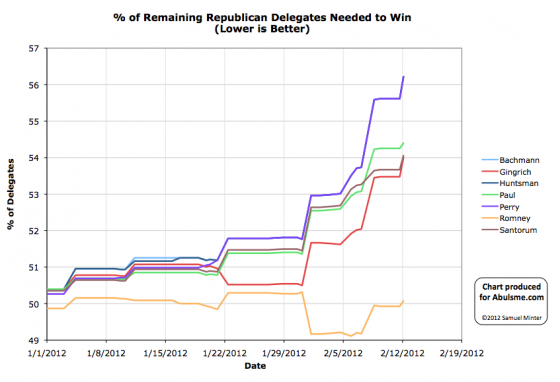
Chart from the Abulsme.com 2012 Republican Delegate Count Graphs page. When a candidate gets down to 0%, they have cinched the nomination. If they get up past 100%, they have been mathematically eliminated.
So. Maine. A few things to say before looking at any numbers here. Maine is another of those states where no actual delegates were designated by the initial caucuses there. Instead, two things happened. First, there was a straw poll. Second, there was the elections to the delegates of the next round. The second thing is actually related to who eventually gets delegates when all is said and done months from now. The first does not. At all. But it is what is reported because it is an easy to understand result. Also, it should be said that some precincts in Maine haven’t even had their caucuses yet. They don’t get to participate in the straw poll (because it is over) but they will get to vote on delegates and such. The “real” result tonight, as in many of the caucus states, is that no delegates at all have been allocated yet.
For this site, we use estimates from The Green Papers for delegates. These assume that the eventual delegate allocation will be proportional to the straw poll results, at least at first approximation. When later rounds of the delegate selection process happen, the numbers will get revised and may be quite different. As an example, the Ron Paul campaign is saying that they think in the end they will actually get the most delegates from Iowa, Minnesota and Colorado because they had their people stay around after the straw polls and actually run to be delegates to the later stages while the other campaigns for the most part ignored this. We shall see how that plays out. In the mean time, while one can look at only completely determined delegates like DCW does in their primary count, but we’ll use the projected eventual delegates from caucus states until better numbers are available later in the process…
Anyway, now on to the main event. Since the last update, we had the preliminary Maine results (estimated as described above), and Ron Paul gained one superdelegate. So for the day, Paul gains 9 delegates, Romney 8, Santorum 4 and Gingrich 1. So Paul wins the day, right? Or maybe like most people saying, it is a win for Romney since he got the most actual votes in the straw poll?
Wrong. The right answer is that after today EVERYBODY is further away from the nomination than they were yesterday. (Paul just lost the least ground.) Nobody got a high enough percentage of the delegates from today to be on track for getting to 1144 delegates before the convention. The delegate take is continuing to be split in such a way that nobody is taking a majority of the delegates.
In fact, with these results, Romney slips below 50% of the delegates allocated so far for the first time since his big delegate win from the winner take all contest in Florida. Prior to today, if he just continued getting delegates at the same percentage he had been so far, he would win the nomination. Since he is now below 50% again, that means he has to actually improve his performance above his historical levels (slightly) to get to 1144.
Of course we have another winner take all state (Arizona) coming up soon, and that may help Romney’s situation considerably if he wins there (as the current polls indicate is likely).
It is also worth pointing out though that even though Romney’s real position in the race (in terms of % of remaining delegates needed to win) was hurt today like everybody’s else’s… the gap between him and his closest competition (still Gingrich, despite Santorum closing rapidly) continues to grow. Romney now needs 50.1% of the remaining delegates to get to 1144. This is just slightly better than the 49.8% he has gotten so far. By comparison, Gingrich now needs 54.0% to catch up and actually get to 1144. This would be a huge change from the 17.9% he has managed so far.
As long as Romney is hovering around 50% of the delegates rather than consolidating and heading rapidly north of that number, we’re going to be hearing the talk about him not managing to get to 1144 and thus potentially ushering in the first brokered convention in decades. While this is an exciting possibility, the road there is still narrow, and Romney is still very much in shooting distance of an outright win.
If however as we hit the next few contents, we see his “% of remaining delegates needed to win” number staying above 50% and actually start to trend consistently UPWARD rather than flat or down… then that talk starts to be more of a real possibility.
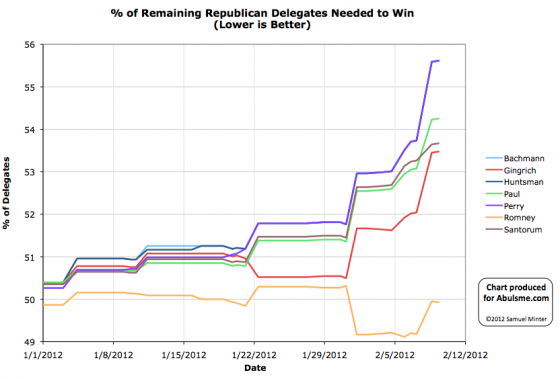
Chart from the Abulsme.com 2012 Republican Delegate Count Graphs page. When a candidate gets down to 0%, they have cinched the nomination. If they get up past 100%, they have been mathematically eliminated.
Romney picks up another superdelegate. This of course slightly improves his sitaution and slightly degrades everybody else’s.
Currently Romney needs 49.9% of the remaining delegates to win. His closest competition, Gingrich, needs 53.5% of the remaining delegates to be able to catch up and win. Santorum needs 53.7%. And finally Paul is furthest behind of the candidates still in the race, needing 54.3% of the remaining delegates to catch up and win.
| In the latest Curmudgeon’s Corner…
Sam talks about:
- Republicans after Nevada
- Commuting / Syria
- Targeting Killings
- Online Privacy
Just click to listen now:
[wpaudio url=”http://www.abulsme.com/CurmudgeonsCorner/cc20120206.mp3″ text=”Recorded 6 Feb 2012″]
or
 1-Click Subscribe in iTunes 1-Click Subscribe in iTunes
 View Podcast in iTunes View Podcast in iTunes
 View XML Feed View XML Feed
|
 |
|
|











